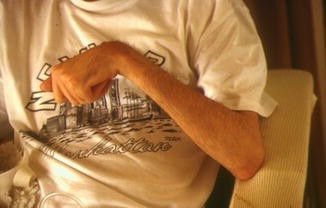Muscle Contractures and Massage
Muscle contractures can occur when a muscle or a group of muscles has not been moved for a long while, a traumatic incident happens to damage the nerves or overstimulate the nervous system. In terms of atrophy, muscle were meant to move but when they don’t, it has negative effects. There is a specific fluid in your body called lymph that needs to circulate throughout, without movement lymph becomes still. This is called lack of lymphatic circulation known as edema. Additionally, after these traumas connective tissue hardens and begins to form. If the contracture happens because of a nerve injury then a series of the body’s responses will happen very fast. Specifically, the muscle will shorten, tighten, to the point of not being able to move normally making it very painful.

Contracture of the hand
As mentioned, the muscle has now become extremely tense. In some cases, you may see the outline of the muscle which looks smaller and more pulled in towards the body. Also, the direction of the way the muscle is fixed will be in an action called flexion. For example, when you bend your elbow it’s known as “flexion”, the upper arm muscles are the primary contracting tissues.
However in a contracture, the muscle never returns to extension (straighten the elbow once again). This is seen mostly in joints of the arms, wrists, knees and ankles.

Arm muscle atrophy due to contracture photo credit link.springer.com
Fortunately, there are ways to prevent contractures or treat them with manual or massage therapy. Understanding the body’s need to move muscle is essential. Below I’ll give categories of how a contracture may occur:
Nerve Damage
- Spinal Cord Injury
- Cerebral Palsy
- Stroke
- Muscular dystrophy
Immobile (unable to move)
- long term bed rest (home)
- having a cast on
- long hospital stay
Contractures have levels of intensity. If the muscle is too compacted then massage therapy can offer some but limited help. However, if the danger of contracture can be foreseen, massage is an excellent way to release tension along with occupational/physical therapy to improve circulation and movement in the joint and muscle. After a stroke massage therapy of the limbs may be useful to lessen or prevent arm and wrist spasticity.
In conclusion, manual or massage therapy plays a valid role is blood and lymph circulation as well as fascia movement for the patient with contractures. Physical and occupational therapists focus on stretching, joint mobilization, ultrasound and electrical stimulation. These methods are helpful but they only occur for a few minutes at a time. Massage therapists have much more time to massage the tension in these areas and can be a great asset to the rehabilitation process. When machines and stretching aren’t enough, massage is that extra level of efficiency.
The state of this muscle is very painful and any assistance to release muscle tension will increase the quality of life of the patient. I would encourage family members to seek providers that are skilled in manual therapy to provide the patient with the much needed relief that they will receive after the above mentioned conditions.


